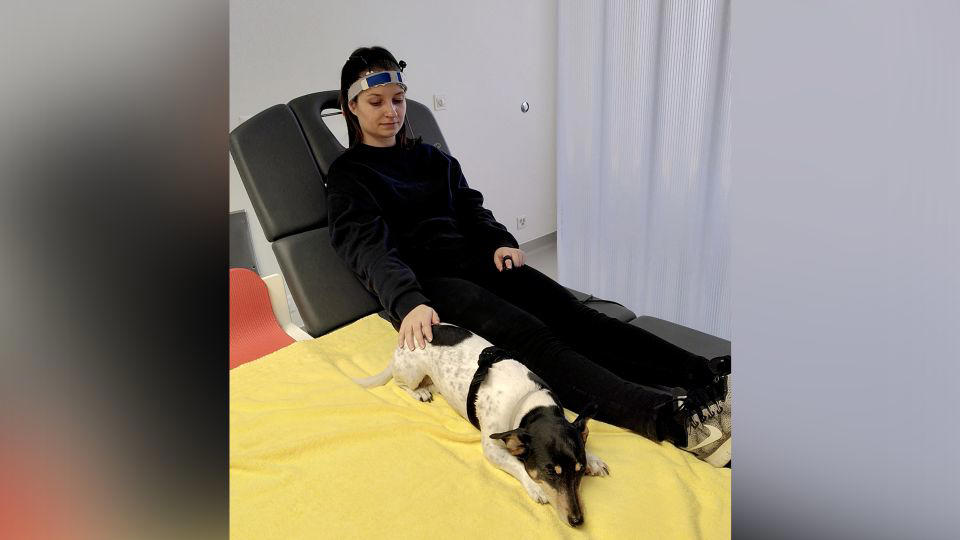On one side of the room sits the cutest life-size stuffed animal you’ve ever seen. On the other side rests a real dog — same size, shape and even the same name as the stuffed version.
You get to sit next to both of these fluffy friends and pet their fur. Guess which one will make your brain light up?
If you guessed the real dog, you’re right. Stuffed animals, as cute and cuddly as they may be, just don’t supercharge our frontal cortex, the part of the brain overseeing how we think and feel, according to a new study published Wednesday in the journal PLOS ONE.
“We chose to investigate the frontal cortex because this brain area is involved in several executive functions, such as attention, working memory, and problem-solving. But it is also involved in social and emotional processes,” said study lead author Rahel Marti, a doctoral student in the division of clinical psychology and animal-assisted interventions at the University of Basel in Switzerland, in an email.
Why is this finding important? It provides additional evidence that live human-animal therapy interactions may boost cognitive and emotional activity in the brain, Marti said.
“If patients with deficits in motivation, attention, and socioemotional functioning show higher emotional involvement in activities connected to a dog, then such activities could increase the chance of learning and of achieving therapeutic aims,” she said.
This latest study adds to existing research on the benefits of animal-assisted therapy in medically supervised neural rehabilitation for nervous system conditions, such as strokes, seizure disorders, brain trauma and infections.
“This is an interesting, rigorously conducted study that provides new insight into associations between human-animal interaction and regional prefrontal brain activity in healthy adults,” said Dr. Tiffany Braley, an associate professor of neurology at the University of Michigan in Ann Arbor, who has published research on the connection between pet ownership and cognitive health.
“Although further work in larger samples of people with specific neurological conditions is needed, the current study could inform future research of animal-assisted interventions for neurorehabilitation by providing new data regarding the type, intensity, and frequency of animal interactions necessary to achieve desired physiological or clinical benefits,” said Braley, who was not involved in the new research.
Researchers used functional near-infrared spectroscopy (fNIRS) in the study, which is a portable brain scanner that provides flexibility since it’s functional in natural settings and not limited to a closed room in a lab. The technique measures brain activity via oxygen saturation of the blood in the brain.
Closer the better
The study team fitted each of 19 participants with the scanner and asked them to observe and interact with one of three live dogs: a Jack Russell terrier, a goldendoodle and a golden retriever. First, study participants watched the dog from across the room. Then the dog sat next to them. Finally, each person was allowed to pet the dog. This process occurred twice more at later dates.

Petting a live dog supercharged activity in the part of the brain that controls thinking and emotional reactions, the study found. – Marti et al., CC-BY 4.0
In other sessions, each person repeated the same sequence with a plush stuffed lion that contained a hot water bottle to simulate the body temperature of a live dog. In each of the scenarios, brain stimulation rose as the dog or stuffed animal moved closer.
“We found that brain activity increased when the contact with the dog or a plush animal became closer. This confirms previous studies linking closer contact with animals or control stimuli with increased brain activation,” Marti said.
However, the study found an even stronger boost in brain activity when the person petted the fur of a real dog versus the stuffed animal.
“We think emotional involvement might be a central underlying mechanism of brain activation in human-animal interactions,” Marti said, adding that the stuffed animal likely triggered less affection.
The results mirror findings by other researchers, who found more brain activity when participants interacted with live rabbits, guinea pigs, cats, dogs and horses, she said.
“Positive nonverbal cues and reciprocal interactions provided by a living animal could in part explain this difference,” Braley said.